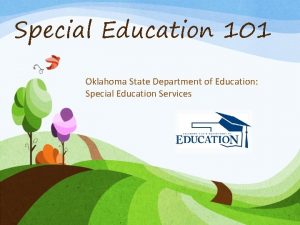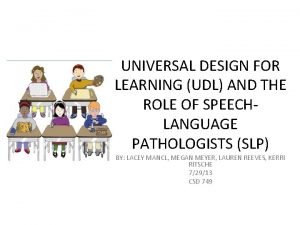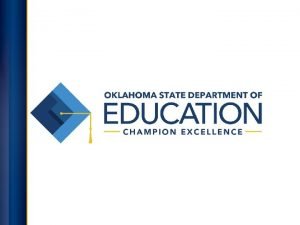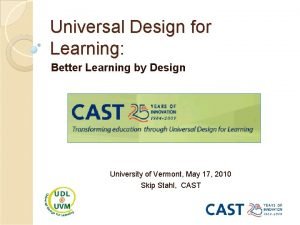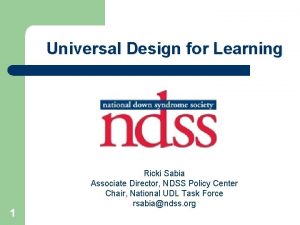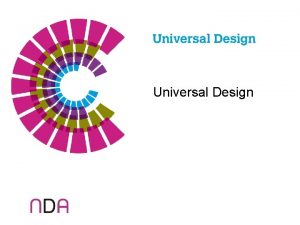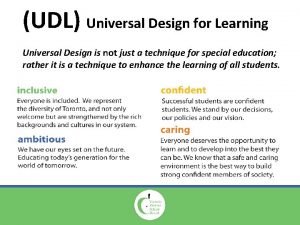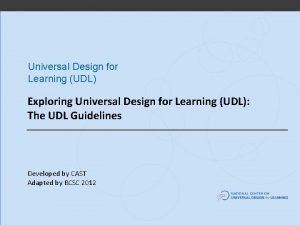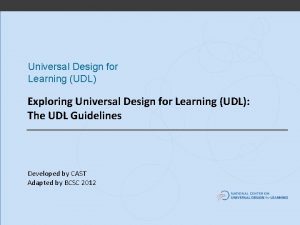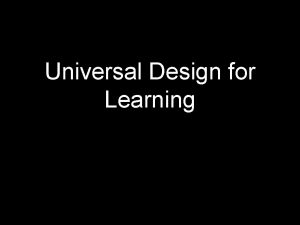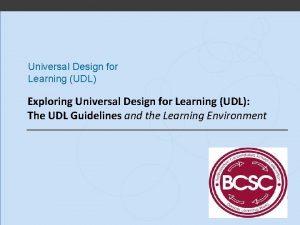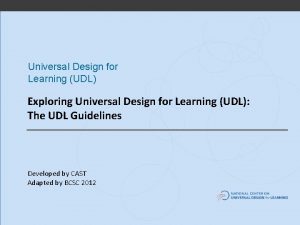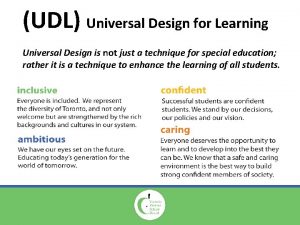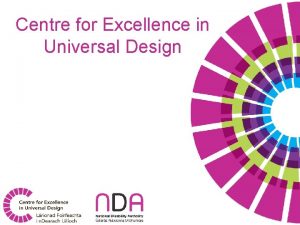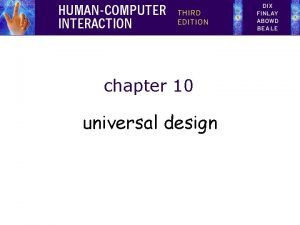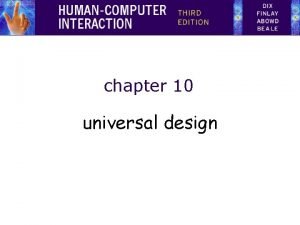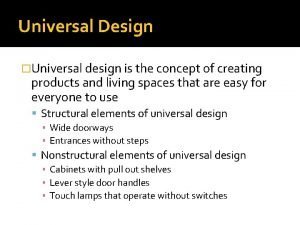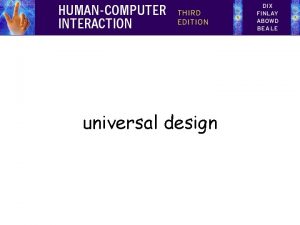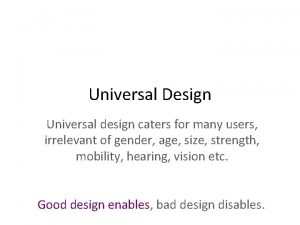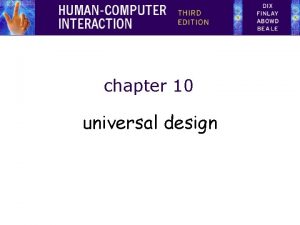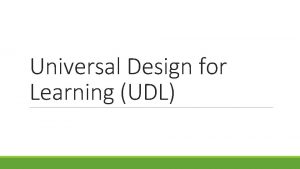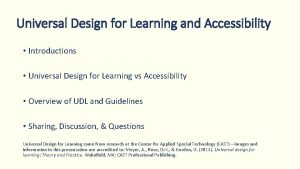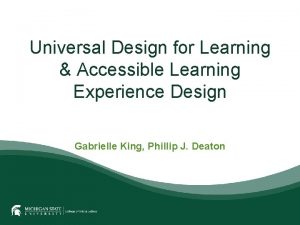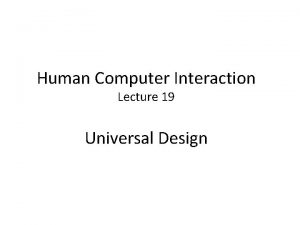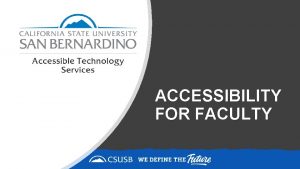Universal Design for Learning Universal Design for Learning





























- Slides: 29

Universal Design for Learning

Universal Design for Learning • CAST members, Anne Meyer and David Rose developed the principles of UDL in the late 1990 s as a framework to improve and optimize teaching and learning for all people based on scientific insights into how humans learn.

Universal Design for Learning • The UDL Guidelines can be used by educators, curriculum developers, researchers, parents, and anyone else who wants to implement the UDL framework in a learning environment. These guidelines offer a set of concrete suggestions that can be applied to any discipline or domain to ensure that all learners can access and participate in meaningful, challenging learning opportunities.

Universal Design for Learning • The UDL Guidelines suggests: – Multiple means of Representation: To give learners various ways of acquiring information and knowledge, – Multiple means of Expression: to provide learners alternatives for demonstrating what they know – Multiple means of Engagement: to tap into learners' interests, offer appropriate challenges, and increase motivation.

Universal Design for Learning T “W he HA T”

Universal Design for Learning Th “H e OW ”

Universal Design for Learning Th “W e HY ”


Universal Design for Learning • Multiple means of Representation – Guideline 1: Provide options for perception – Guideline 2: Provide options for language, mathematical expressions, and symbols – Guideline 3: Provide options for comprehension

Universal Design for Learning • Multiple means of Representation – Guideline 1: Provide options for perception – Checkpoint 1. 1 – Offer ways of customizing the display of information – Checkpoint 1. 2 - Offer alternatives for auditory information – Checkpoint 1. 3 - Offer alternatives for visual information

Universal Design for Learning • Multiple means of Representation – Guideline 1: Provide options for perception e. g. change the font e. g. change the speed size, type, and colour. of a video or an audio Also change the – Checkpoint 1. 1 – Offer ways of customizing file the display of background information – Checkpoint 1. 2 - Offer alternatives for auditory information – Checkpoint 1. 3 - Offer alternatives for visual information e. g. create captions, e. g. follow accessibility and allow text-tostandards (DAISY, speech. Consider NIMAS, etc. ) tactile interfaces

Universal Design for Learning • Multiple means of Representation – Guideline 2: Provide options for language, mathematical expressions, and symbols – Checkpoint 2. 1 - Clarify vocabulary and symbols – Checkpoint 2. 2 - Clarify syntax and structure – Checkpoint 2. 3 - Support decoding of text, mathematical notation, and symbols – Checkpoint 2. 4 - Promote understanding across languages – Checkpoint 2. 5 - Illustrate through multiple media

Universal Design for Learning • Multiple means of Representation e. g. 2: pre-teach – Guideline Provide options for language, mathematical vocabulary e. g. make explicit links expressions, andand symbols between parts of the symbols, so that it connects to the teaching content – Checkpoint 2. 1 - Clarify vocabulary and symbols students – Checkpoint 2. 2 - Clarify syntax and structure – Checkpoint 2. 3 - Support decoding of text, mathematical e. g. provide access to e. g. provide links to notation, and symbols alternative online translation – Checkpoint 2. 4 - Promote understanding acrosstools languages representations of and multilingual – Checkpoint 2. 5 - Illustrate through multiple media mathematical notations. glossaries.

Universal Design for Learning • Multiple means of Representation – Guideline 3: Provide options for comprehension – Checkpoint 3. 1 - Activate or supply background knowledge – Checkpoint 3. 2 - Highlight patterns, critical features, big ideas, and relationships – Checkpoint 3. 3 - Guide information processing, visualization, and manipulation – Checkpoint 3. 4 - Maximize transfer and generalization

Universal Design for Learning • Multiple means of Representation – Guideline 3: Provide e. g. link topics tooptions for comprehension e. g. to emphasise student’s previous critical content, use knowledge and cross- or supply multiple examples, knowledge and – Checkpoint 3. 1 - Activate background curricular – Checkpoint 3. 2 topics - Highlight patterns, non-examples critical features, big ideas, and relationships – Checkpoint 3. 3 - Guide information processing, visualization, e. g. provide a visual e. g. “chunk” and manipulation organiser to show a information into smaller – Checkpoint 3. 4 - Maximize transfer and generalization sequence of topics, but elements, and memory give the students the mnemonics and tools choice of “entry-point”

Universal Design for Learning • Multiple means of Expression – Guideline 4: Provide options for physical action – Guideline 5: Provide options for expression and communication – Guideline 6: Provide options for executive functions

Universal Design for Learning • Multiple means of Expression – Guideline 4: Provide options for physical action – Checkpoint 4. 1 - Vary the methods for response and navigation – Checkpoint 4. 2 - Optimize access to tools and assistive technologies

Universal Design for Learning • Multiple means of Expression e. g. provide alternative – Guideline 4: Provide options for physical action e. g. provide alternative ways of accessing keystrokes for mouse content, in terms of actions, and access to – Checkpoint 4. 1 and - Vary the methods for response and rate, timing, motor alternative keyboards navigationaction. – Checkpoint 4. 2 - Optimize access to tools and assistive technologies e. g. only use software e. g. explore the use of that works with a range switch and scanning of assistive access for your content. technologies.

Universal Design for Learning • Multiple means of Expression – Guideline 5: Provide options for expression and communication – Checkpoint 5. 1 - Use multiple media for communication – Checkpoint 5. 2 - Use multiple tools for construction and composition – Checkpoint 5. 3 - Build fluencies with graduated levels of support for practice and performance

Universal Design for Learning • Multiple means of Expression – Guideline 5: Provide options fore. g. expression and e. g. consider using use social media, communication text, speech, drawing, interactive web tools, film, music, dance, simulations, chats, visual art, 5. 1 sculpture. – Checkpoint - Use multiple mediaanimations. for communication – Checkpoint 5. 2 - Use multiple tools for construction and composition e. g. provide multiple – Checkpoint 5. 3 sample - Build fluenciese. g. withprovide graduated levels of sentences, andand performance model solutions to real support for practice sentence starters. Use problems, and concept mapping tools. differentiated feedback.

Universal Design for Learning • Multiple means of Expression – Guideline 6: Provide options for executive functions – Checkpoint 6. 1 - Guide appropriate goal-setting – Checkpoint 6. 2 - Support planning and strategy development – Checkpoint 6. 3 - Facilitate managing information and resources – Checkpoint 6. 4 - Enhance capacity for monitoring progress

Universal Design for Learning • Multiple means of Expression create guides and – Guideline 6: Provide options fore. g. executive functions e. g. create guides and checksheets to embed checksheets to identify points to reflect at, and milestones, and to help – Checkpoint 6. 1 - Guide appropriate goal-setting point to show your estimate effort. – Checkpoint 6. 2 - Support planning and work. strategy development – Checkpoint 6. 3 - Facilitate managing information and resources e. g. create 6. 4 guides and capacity e. g. create guides and – Checkpoint - Enhance for monitoring progress checksheets for selfnotetaking, and assessment, and categorizing. sample rubrics.

Universal Design for Learning • Multiple means of Engagement – Guideline 7: Provide options for recruiting interest – Guideline 8: Provide options for sustaining effort and persistence – Guideline 9: Provide options for self-regulation

Universal Design for Learning • Multiple means of Engagement – Guideline 7: Provide options for recruiting interest – Checkpoint 7. 1 - Optimize individual choice and autonomy – Checkpoint 7. 2 - Optimize relevance, value, and authenticity – Checkpoint 7. 3 - Minimize threats and distractions

Universal Design for Learning • Multiple means of Engagement createinterest activities – Guideline 7: Provide options for e. g. recruiting e. g. provide students that are personalized, with choice in terms of relevant (culturally and challenge, rewards, – Checkpoint 7. 1 - Optimize individual choice and autonomy socially), and ability timing of 7. 2 sub-tasks. – Checkpoint - Optimize relevance, value, and authenticity appropriate. – Checkpoint 7. 3 - Minimize threats and distractions e. g. create activities that foster problem solving, and encourage the use of imagination. e. g. create a supportive and accepting classroom environment.

Universal Design for Learning • Multiple means of Engagement – Guideline 8: Provide options for sustaining effort and persistence – Checkpoint 8. 1 - Heighten salience of goals and objectives – Checkpoint 8. 2 - Vary demands and resources to optimize challenge – Checkpoint 8. 3 - Foster collaboration and community – Checkpoint 8. 4 - Increase mastery-oriented feedback

Universal Design for Learning • Multiple means of Engagement e. g. encourage e. g. focus effort less on – Guideline 8: Provide options for sustaining and students to define and external evaluation, persistence focus on goals; and focus on effort and explore what improvement in – Checkpoint 8. 1 means. - Heighten salience of goals and objectives excellence meeting standards. – Checkpoint 8. 2 - Vary demands and resources to optimize challenge e. g. provide feedback e. g. use peer-review – Checkpoint 8. 3 - Foster collaboration and community that is frequent, timely, and peer-tutoring. – Checkpoint 8. 4 - Increase mastery-oriented feedback and relevant. Also that Create rubrics and emphasises effort and guides for groupwork. improvement.

Universal Design for Learning • Multiple means of Engagement – Guideline 9: Provide options for self-regulation – Checkpoint 9. 1 - Promote expectations and beliefs that optimize motivation – Checkpoint 9. 2 - Facilitate personal coping skills and strategies – Checkpoint 9. 3 - Develop self-assessment and reflection

Universal Design for Learning • Multiple means of Engagement e. g. create guides and e. g. use real life – Guideline 9: Provide options for self-regulation checksheets to reduce examples or frustration, and to keep simulations to – Checkpoint - Promote expectations and beliefs on-task 9. 1 in spite of demonstrate copingthat optimize motivation distractions. skills. – Checkpoint 9. 2 - Facilitate personal coping skills and strategies e. g. assist the students e. g. assist 9. 3 students in self-assessment and reflection – Checkpoint - Develop in identifying their overcoming specific personal goals, and topics that they have their own strengths and phobias about. weaknesses.
 Universal design for learning definition
Universal design for learning definition Udl
Udl Universal design for learning
Universal design for learning What is the diencephalon
What is the diencephalon Universal design for learning
Universal design for learning Cuadro comparativo e-learning y b-learning
Cuadro comparativo e-learning y b-learning Fspos
Fspos Typiska drag för en novell
Typiska drag för en novell Nationell inriktning för artificiell intelligens
Nationell inriktning för artificiell intelligens Ekologiskt fotavtryck
Ekologiskt fotavtryck Shingelfrisyren
Shingelfrisyren En lathund för arbete med kontinuitetshantering
En lathund för arbete med kontinuitetshantering Kassaregister ideell förening
Kassaregister ideell förening Personlig tidbok fylla i
Personlig tidbok fylla i A gastrica
A gastrica Densitet vatten
Densitet vatten Datorkunskap för nybörjare
Datorkunskap för nybörjare Tack för att ni lyssnade bild
Tack för att ni lyssnade bild Debattartikel struktur
Debattartikel struktur Delegerande ledarskap
Delegerande ledarskap Nyckelkompetenser för livslångt lärande
Nyckelkompetenser för livslångt lärande Påbyggnader för flakfordon
Påbyggnader för flakfordon Kraft per area
Kraft per area Publik sektor
Publik sektor Jag har nigit för nymånens skära
Jag har nigit för nymånens skära Presentera för publik crossboss
Presentera för publik crossboss Jiddisch
Jiddisch Vem räknas som jude
Vem räknas som jude Klassificeringsstruktur för kommunala verksamheter
Klassificeringsstruktur för kommunala verksamheter Epiteltyper
Epiteltyper
